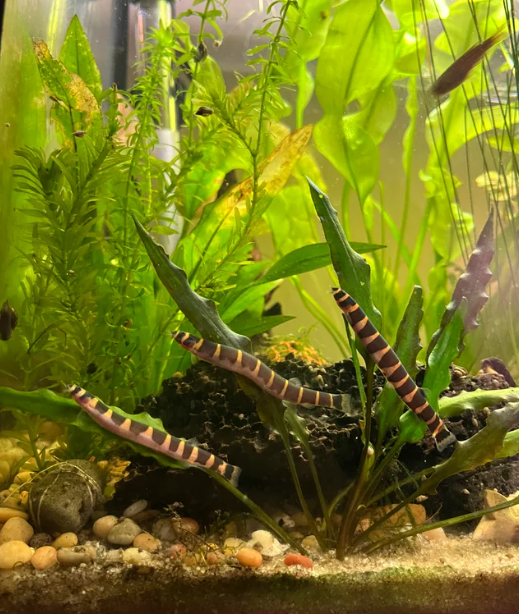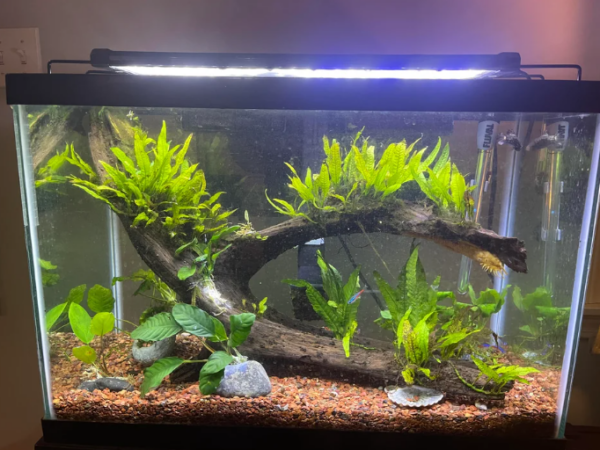Kuhli Loaches (Pangio kuhlii), aka Eel Loaches, are native to the Southeast Asian freshwater rivers in Indonesia, Malaysia, Thailand, and Borneo. They’re pretty common on the Java island in Indonesia.
Despite being shy and peaceful, Kuhli Loaches are pretty popular in the aquarium trade for their interesting appearance and unique set of behaviors. This includes their burrowing, schooling, and foraging actions.
Owing to years of selective breeding, Kuhli Loaches have undergone mutations that have given them unique colorations and patterns.
While the objective of this article is to discuss different Kuhli Loach colors, we’ll dive deeper and provide you a brief care guide with it.
Table of Contents
Kuhli Loach Overview and General Appearance
| Information Chart | Kuhli Loach |
| Scientific Name: | Pangio kuhlii |
| Family: | Cobitidae |
| Care Level: | Moderate |
| Temperament: | Peaceful and shy |
| Color: | Black, Yellow, Brown, Red, Silver, Green, Purple |
| Lifespan: | 10 years |
| Size: | 3 to 5 inches |
| Diet: | Omnivorous. Frequent protein-based food and occasional vegetable matter. |
| Minimum Tank Size: | 20 gallons |
| Temperature: | 75 to 82F |
| WaterConditions: | pH 6.0 to 7.0 Soft to moderately hard water |
| Tank Mate Compatibility | Other small peaceful fish. Avoid competitive bottom-dwellers. |
Belonging to the Cobitidae family, Kuhli Loaches live in slow-flowing rivers with plenty of vegetation. They prefer to inhabit areas with softer substrates, such as sand, to practice their foraging and burrowing behavior.
Being bottom-dwellers and scavengers, they have an elongated and cylindrical body shape–resembling an eel. Their head and tail are narrower than the mid-body. As for the size, Kuhlis don’t go beyond 3-4 inches in captivity. However, up to 5 inches is pretty common in the wild.
They come in different colors and patterns which we’ll discuss in the next part. To simplify, the most common Kuhli Loach colors include black, yellow, brown, silver, and purple. Contrasting, vibrant, vertical stripes also are defining features of Kuhli Loaches.
Contrary to most beliefs, Kuhli Loaches do have body scales, but they’re so fine that they’re easy to miss and disregard. However, head scales are completely absent in Kuhli Loaches. They have a smooth and elegant skin texture.
Be aware that Kuhli Loaches have tiny teeth to chomp on organic matter. However, those aren’t prominent enough to bite on larger fish or humans.
Although the pink and black Kuhli are the most common, various color choices are available for your aquarium.
Kuhli Loach Colors
Kuhli Loaches differ in both base and stripe color. While Kuhlis often are identified with different common names depending on their color, they belong to the same family.
1. Black Half-Banded Kuhli Loach
Black half-banded is by far the most common Kuhli Loach color. However mundane it may sound, the black shade of Kuhli Loaches often involves shades of gray and brown to create a stark contrast with substrates and plants.
The vertical stripes on half-banded black Kuhli Loaches are typically darker and help break up their silhouette in the natural environment. However, the exact shade, shape, and thickness of the stripes may vary.
Fine gravel mix and sand are the most well-suited substrate choice for black Half-banded Kuhli Loaches. However, as you should have plants within, a soil mix with sand overlay is recommended.
2. Leopard Kuhli Loach (Black)
Similar to the coloration of the Black Half-Banded Kuhli Loaches, the Leopard Kuhli Loaches have a prominent leopard-like stripe pattern. These darker patterns are more random and cover their whole body, including the head.
A similar soil mix with sand overlay is the recommended substrate choice for Leopard Kuhlis.
3. Black Kuhli Loach
Stripes or patterns are absent in Black Kuhlis. They’re solid black or gray in color and appearance-wise aren’t very interesting. But, they aren’t actually fully black. Their underbelly is much paler in color and has a pale pink hue.
These Kuhlis can grow up to 7 inches in the wild and are among the larger Kuhli varieties.
4. Red Kuli Loach
Similar in patterns to Half-banded Black Kuhlis, the Red Kuhli Loaches are identified by their faint reddish body, darker stripes, and white dots on their fins. Unlike Black Kuhlis, the red ones have darker patches on their underbelly, eyes, and fins.
Black soft sand can enhance the vibrancy of Red Kuhlis, but any soft substrate that works for Half-Banded Kuhlis should work.
5. Silver Kuhli Loach
The only iridescent Kuhli Loach variety, the Silver Kuhlis are lighter gray to cream in coloration. While the name may suggest a monotonous appearance, these Kuhlis demonstrate a patchwork of grays and blacks throughout their body and tails.
Depending on the individual fish, the shade of silver and the patterns may change.
Fine gravel and sand are the best substrate choices for Silver Kuhlis
6. Albino Kuhli Loaches (Light Purple)
Usually a result of captive breeding, the Albino Kuhli Loaches are light purple in color with a darker patch around their head. Albino Kuhli isn’t considered a new variety, instead, they’re simply the result of an absence of natural colors present in other Kuhlis.
Similar substrate choices apply to Albino Kuhlis.
Kuhli Loach Care and Tank Setup
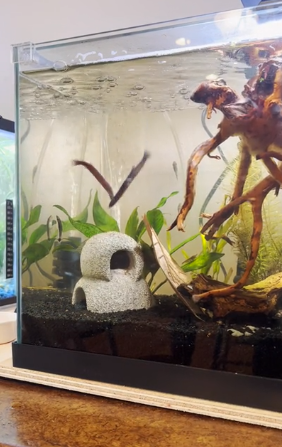
Moving on from coloration and appearance, let’s discuss proper care and tank setup for Kuhli Loaches.
1. Tank Size
Kuhli Loaches are relatively small yet active fish. They appreciate a larger swimming space with ample space to hide and explore. Therefore, at least a 20-gallon tank for a single loach with plants or a 30-gallon for 2 or 3 Kuhlis should be adequate.
Kuhlis being bottom-dwellers and air gobblers, horizontal tanks with larger depths should be preferred over more width to reduce competition and stress.
In a community setup, go for the largest tank that you can sustain. Your Kuhlis will appreciate the peace and demonstrate their naturally interesting behaviors.
2. Filter Type
As Kuhlis don’t have prominent scales, they’re more susceptible to infections and parasitic attacks. This specimen of Loaches, thereby, prefers a clean, well-balanced tank with appropriate parameters.
For that, canister filters seem like the obvious choice. But, Kuhlis require a slow-moving water flow to thrive.
Alternatively, hang-on-back (HOB) filters, paired with sponge filters and regular water changes, are most well-suited for Kuhli Loaches. Furthermore, ensure that your filter is flow-rate adjustable.
If you must use a canister filter, make sure to adjust the flow rate to a minimum when keeping Kuhli Loaches. Additionally, you may use a solid foam to reduce the output flow.
3. Substrate
As mentioned, sand and fine gravel are the best substrates for Kuhli Loaches. Focus on offering a close-to-natural environment to your Kuhlis. lay sand and soil to cater to both your fish and plants.
Sand is preferred for this species to sustain their burrowing practices. Kuhlis love to dig in the substrate and scavenge for food. As they’re likely to continue their activities even with harder and sharper substrates, such as crushed coral or glass beads, those should be avoided.
Moreover, to sustain their burrowing behavior, the substrate should be at least 2 inches deep.
4. Water Temperature
Kuhli Loaches are tropical fish and require year-round stable temperatures. They aren’t quite forgiving to temperature shocks and absolutely can’t stand extreme colder climates. Maintain a temperature range of 75 to 82 degrees Fahrenheit or 24 to 28 degrees Celcius for them to thrive.
To increase the water temperature, an adjustable thermometer with accurate controls should be adequate for an average 20-gallon tank. On the other hand, flow generators and water changes can reduce the temperature of the aquarium to a significant level.
5. pH Level and Water Hardness
Maintain a slightly acidic pH of 6.0 to 7.0 to provide a comfortable environment. Being sensitive fish, Kuhli Loaches can’t tolerate acidic or alkaline water beyond the safe range. There may not seem much difference between 7.0 and 7.5, but pH is calculated on a logarithmic scale and the disparity is huge.
Lower the pH by using RO water during water changes. You may also consider driftwood and other pH-lowering plants. If it’s too low, use commercial buffers to balance the pH out.
As for the water hardness levels, 5 to 15 dGH is recommended for Kuhli Loaches. But, they can tolerate much higher hardness if required. An irregular water hardness level may develop osmoregulatory, respiratory, and growth-related issues.
Kuhli Loach Tank Landscape
Hiding and exploration spots are necessary to keep Kuhli Loaches. Being tropical fish, they’re wired to be comfortable around aquatic plants and driftwood.
Best Plants for Kuhli loach
The best plants for Kuhli Loaches are:
- Java Fern
The Java Fern serves as an ideal addition to Kuhli Loach tanks. This remarkable plant not only contributes to maintaining a clean aquatic environment but also provides a safe haven for your loaches—shielding them from potential predators and undue stress.
- Ice Plant
The Ice Plant requires minimal maintenance. They grow slowly and rarely escalate over the tank. Additionally, the Ice Plant boasts abundant foliage. Which provides shade and lets your loaches receive ample oxygen during the summer months.
- Dwarf Sword Fern
Growing to an impressive 4 inches, the Dwarf Sword Fern is an excellent choice for aquarists seeking a hassle-free plant that provides ample shade for their Kuhli Loaches.
- Java Moss
This soft and spongy moss exhibits rapid growth, providing your loaches with ample hiding spots. In addition, Java Moss keeps the water clean by filtering organic material.
Worst Plants for Kuhli Loach
The worst plants for Kuhli Loaches are:
- Floating Plants
Floating plants like Frogbit, Duckweed, and Salvinia aren’t harmful to Kuhli Loaches, but they can obstruct their swimming pattern. Their root systems often cause trouble for loaches.
- High-Maintenance Plants
Owing to their burrowing behavior, Kuhli Loaches tend to disturb high-maintenance plants with delicate root systems.
Decorations for Kuhli Loach
To provide further exploration and hiding spaces, decorations can be great alternatives.
- Caves and Tunnels
Put Pieces of PVC pipes and similar things into the substrate to help your Kuhlis burrow and explore. Insert the pipes at a lower angle to make dwelling easier for them.
- Driftwood
In addition to offering a natural hiding spot for your Kuhlis, driftwood releases tannins into the water, which helps lower the pH.
- Smooth Rocks
Decorate the bottom with structures created by smooth rocks. As the Kuhli Loaches are bottom-dwellers, try to avoid sharp rocks.
Feeding Kuhli Loach
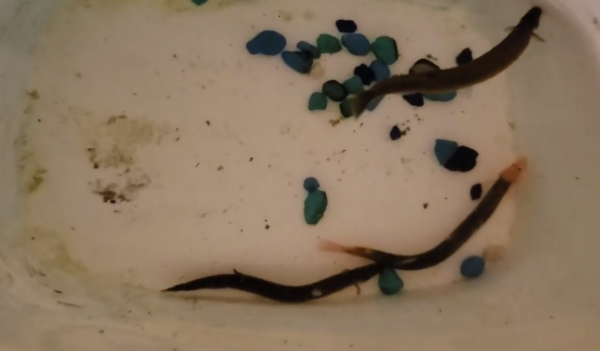
Although Kuhli Loaches are known to be omnivorous, they rely mostly on a protein-rich diet of leftover organic matter. While you can make them get used to a daytime feeding habit, they’re more comfortable in scavenging the substrate at night.
They rarely come to the surface to eat. Therefore, you need to hand-feed them a diet of bloodworms, sinking pellets, and brine shrimp. They won’t be much interested in eating the plants or vegetables.
Usually, you don’t need to feed Kuhli Loaches. But, if you only have them in the tank, feed them bloodworms twice or thrice a week. Loach flake food can be given once per day, but brine shrimps should be kept limited to 5 specimens per week.
Tank Mates for Kuhli Loach
Kuhli Loaches are pretty non-aggressive and peaceful fish species. A few community tank members that are equally suitable for Kuhlis, are:
Ideal Tank Mates for Kuhli Loach
- Corydoras
Corydoras are small bottom-dwelling catfish that are non-competitive and share a similar habitat with Kuhli Loaches.
- Mollies
Molly Fish are suitable for beginner aquarists, for their ability to adapt to most environments. They’re equally non-aggressive and keep themselves limited to surface and mid.
- Rasboras
Rasboras are small schooling fish that share a similar habitat with Kuhli Loaches. They prefer to swim in a group and don’t disturb other fish species.
- Danios
Except for Zebra Danios, who exhibit some fin-nipping behavior, Danios are pretty well-suited for Kuhli Loach aquariums. They’re small and peaceful.
- Tetras
Similar to Rasboras, Tetras also form groups and demonstrate schooling behavior. They’re well-suited for Kuhli tanks.
- Guppies
Guppies are adaptable, shy, and peaceful fish well-suited with Kuhli Loaches. They also are a great addition to planted tanks.
- Honey Gouramis
These small and peaceful Gouramis are a good match for Kuhli loaches. They both appreciate similar water conditions and peacefully coexist
- Cherry Shrimp
Cherry shrimp, being great for planted aquariums, is a worthy addition to your Kuhli Loach tanks. They are vibrant and enhance the colors of both the tank and your Loach.
Bad Tank Mates for Kuhli Loach
A few species that are considered bad tank mates for Kuhli Loaches are:
- Small Snails
Kuhlis eat small snails. They shouldn’t be kept with them till they’re over a few centimeters in size.
- Competitive Bottom-Dwellers
Bottom-dwellers who constantly fight for space and food aren’t suitable for Kuhli Loaches. They may fatally harm your Kuhlis.
- Aggressive Fish
Predator and aggressive fish species may harass or prey on Kuhli Loaches.
Facts About Kuhli Loach
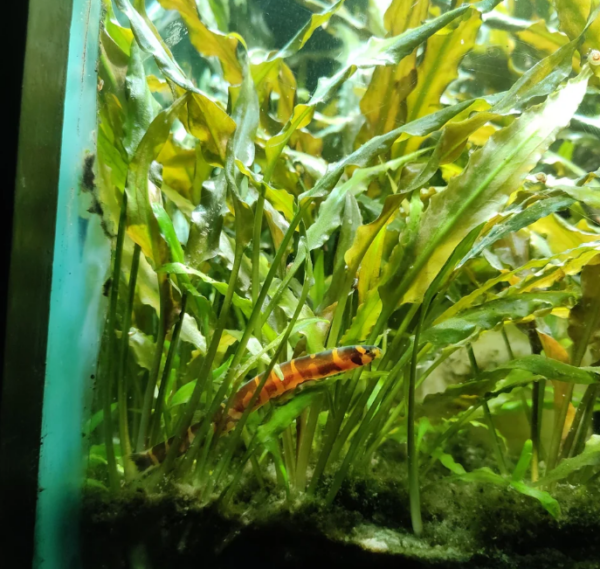
- Kuhli loaches are master burrowers. They use their snouts to dig into the substrate to create tunnels and hiding spots.
- They have a unique habit of darting to the water’s surface to gulp air. They can absorb oxygen from the atmosphere.
- Kuhli loaches are partially schooling fish that thrive when kept in small groups. Kuhlis swim and interact in playful ways.
- These fish are skilled at navigating tight spaces and crevices. This makes them excellent escape artists when they want to hide.
- Despite their eel-like appearance, Kuhli loaches belong to the catfish family. They share various common traits with their catfish relatives.
- Kuhli loaches are known for their distinctive vertical stripes. However, they vary in intensity and pattern among individual fish.
- They are excellent scavengers. Kuhlis help control detritus and small food particles in the substrate.
- Their name, “Kuhli loach,” is derived from their scientific name, Pangio kuhlii. They are also commonly referred to as “Coolie Loach” or “Prickly Eye.”
FAQs
No, Kuhli Loaches are pretty non-aggressive fish and are happy with scavenging, sinking pellets, and occasional brine shrimp treats. Moreover, they don’t have the necessary mechanism to hunt and pray.
2 to 3 Kuhli Loaches can be kept together in a 30-gallon tank. They’re quite social. Kuhlis play among themselves and burrow together.
Yes, Kuhlis will keep your tank clean from uneaten food and rotting organic matter. However, they don’t eat algae and other plant matter.
No, Kuhli loaches are a very friendly fish species. They’ll get excited to see you around and will playfully interact with their tank environment.
The Bottom Line
We’ve discussed the color varieties of Kuhli Loaches and a brief care guide for the same. Hopefully, you’ll now be able to choose the best variant for your aquarium and care for these sensitive lovelies properly.
No related posts.

